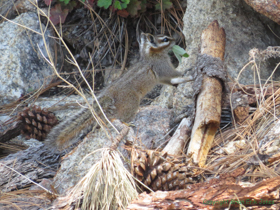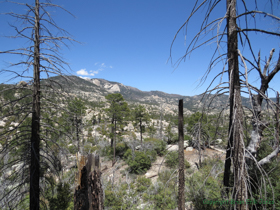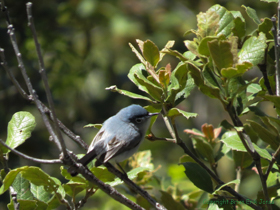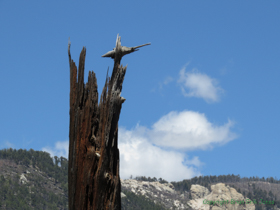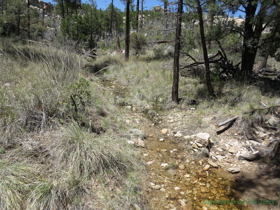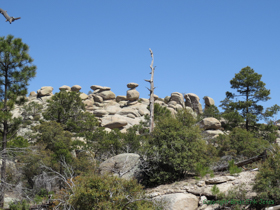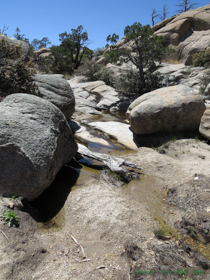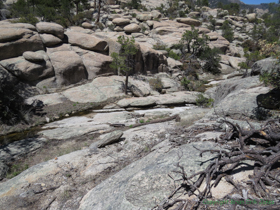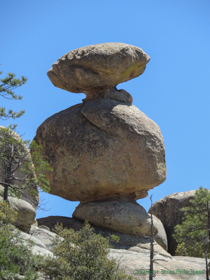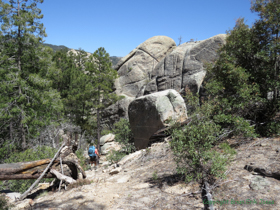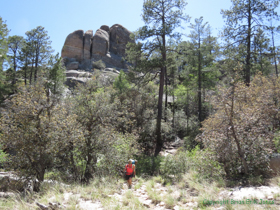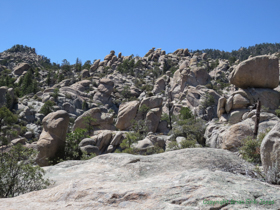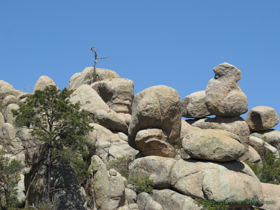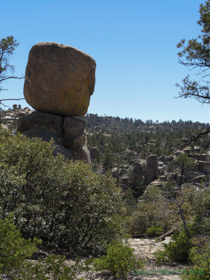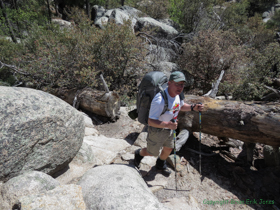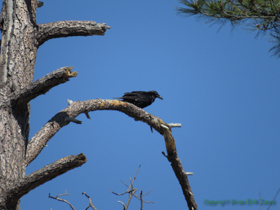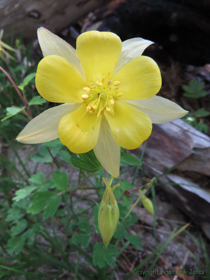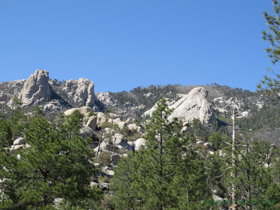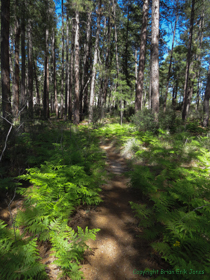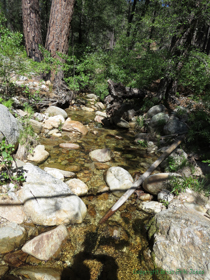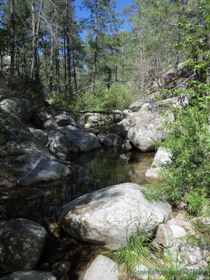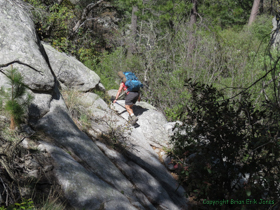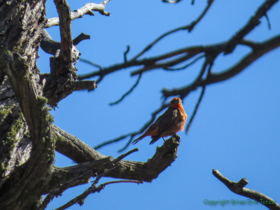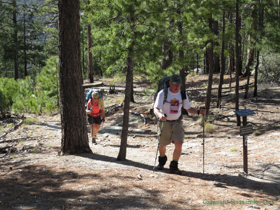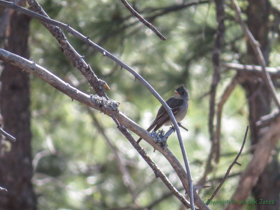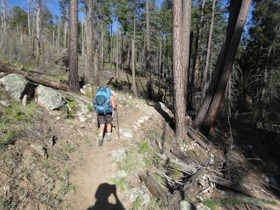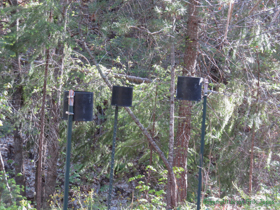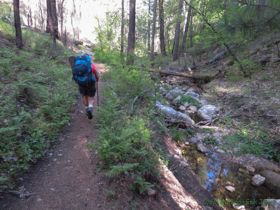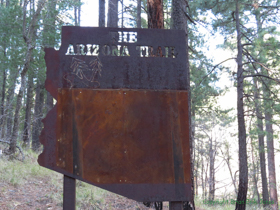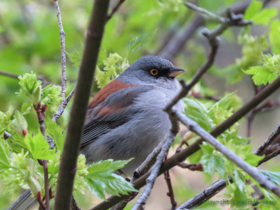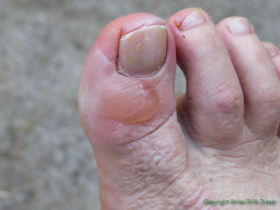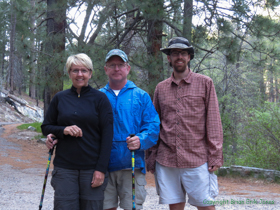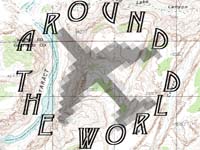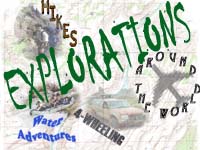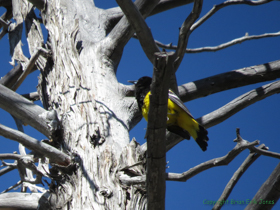 I was ready to go a little before Jerry and Andrea, so I decided to head out and do some birding in the riparian area just up the trail.
I was ready to go a little before Jerry and Andrea, so I decided to head out and do some birding in the riparian area just up the trail. 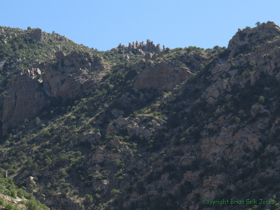
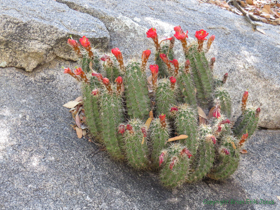 It looked like there were some good campsites in the area. The riparian area wasn't as birdy as I had hoped (though I did see a Scott's Oriole (Icterus parisorum)), but just afterwards, an Arizona Black Rattlesnake perched in a low branch by the trail let me know he was there with a vigorous tail shake. He was a big boy, and a cool find. I decided to wait there until Jerry and Cheetah came along to make sure they saw it, and only had to wait a couple of minutes. Jerry said that they saw another one a short distance back that I had missed.
It looked like there were some good campsites in the area. The riparian area wasn't as birdy as I had hoped (though I did see a Scott's Oriole (Icterus parisorum)), but just afterwards, an Arizona Black Rattlesnake perched in a low branch by the trail let me know he was there with a vigorous tail shake. He was a big boy, and a cool find. I decided to wait there until Jerry and Cheetah came along to make sure they saw it, and only had to wait a couple of minutes. Jerry said that they saw another one a short distance back that I had missed.
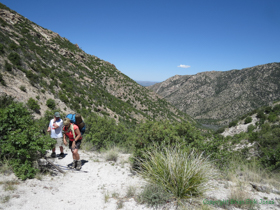
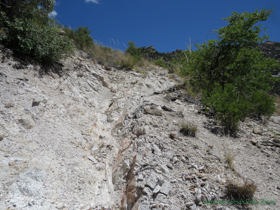
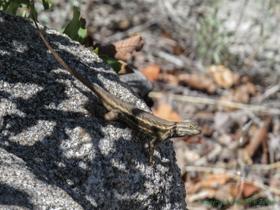 We climbed up to Romero Pass, which marks the end of Passage 11 and the beginning of Passage 12. Again, this passage transition occurs in the middle of nowhere, so someone who is segment hiking has only the choice to continue on, or hike all the way back out. If I was king of the world, I would move the break point to Marshall Gulch. The climb up to Romero Pass is a healthy climb but from there, the trail gets steeper and rockier. So much so that it isn't recommended for equestrians. The trail climbs, and climbs, and climbs.
We climbed up to Romero Pass, which marks the end of Passage 11 and the beginning of Passage 12. Again, this passage transition occurs in the middle of nowhere, so someone who is segment hiking has only the choice to continue on, or hike all the way back out. If I was king of the world, I would move the break point to Marshall Gulch. The climb up to Romero Pass is a healthy climb but from there, the trail gets steeper and rockier. So much so that it isn't recommended for equestrians. The trail climbs, and climbs, and climbs.
We stopped for lunch part way up, then kept on climbing. There were quite a few Plateau Fence Lizards (Sceloporus tristichus) and Ornate Tree Lizards (Urosaurus ornatus) along the trail, which I enjoyed watching and trying to photograph. The trail is very well done, which is a bit surprising given the ruggedness of the terrain. The trail navigates up and around large boulders, slabs of bedrock, outcrops and spires. It is a truly beautiful place.
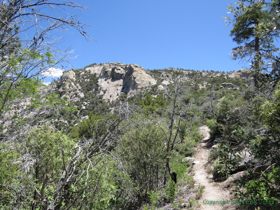
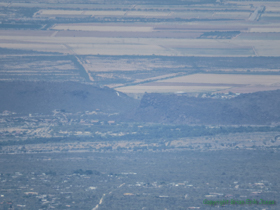 As we climbed higher we got better and better views of the valley below. While hiking along a spiny ridgeline I looked out to the west I could actually see my house! Though at around 20 miles away, seeing it did require binoculars.
As we climbed higher we got better and better views of the valley below. While hiking along a spiny ridgeline I looked out to the west I could actually see my house! Though at around 20 miles away, seeing it did require binoculars.
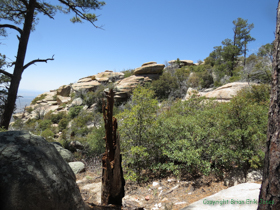
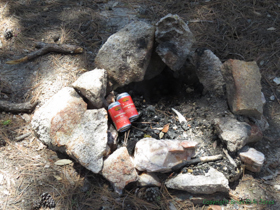 As we neared the top we passed a campsite at which someone had left a few unopened beers. Knowing how much Jerry and Cheetah like beer, I threw a few in my pack, and Jerry took some too. I actually tried one later, and it didn't not even come close to living up to the expectation I had for a 'watermelon ale'. I should have known that beer turns pretty much anything to piss. It was good to remove them from the wilderness anyway. They really were just litter.
As we neared the top we passed a campsite at which someone had left a few unopened beers. Knowing how much Jerry and Cheetah like beer, I threw a few in my pack, and Jerry took some too. I actually tried one later, and it didn't not even come close to living up to the expectation I had for a 'watermelon ale'. I should have known that beer turns pretty much anything to piss. It was good to remove them from the wilderness anyway. They really were just litter.
I kept hoping that at the next campsite someone would have left something good like a hard cider, but I had no such luck. We did have amazing scenery and cute chipmunks though, which is even better. As we neared the top of the mountain I started seeing more birds, and wildflowers became more abundant as well. It really was a gorgeous area.
It was evening time by the time we got to Marshall Gulch trailhead. The AZT sign there shows that the trail is pretty much a blank slate (see below). Just head northwest until you see two pine trees . . .
We hung out for a while and Cheetah bragged about her monstrous toe blister (she always has to prove she's tougher than us boys by hiking through more pain). After a while we started the drive back down the mountain and towards home, with another beautiful AZT passage (and a half) complete.
We hiked about 10 miles today.




 I was ready to go a little before Jerry and Andrea, so I decided to head out and do some birding in the riparian area just up the trail.
I was ready to go a little before Jerry and Andrea, so I decided to head out and do some birding in the riparian area just up the trail. 
 It looked like there were some good campsites in the area. The riparian area wasn't as birdy as I had hoped (though I did see a Scott's Oriole (Icterus parisorum)), but just afterwards, an Arizona Black Rattlesnake perched in a low branch by the trail let me know he was there with a vigorous tail shake. He was a big boy, and a cool find. I decided to wait there until Jerry and Cheetah came along to make sure they saw it, and only had to wait a couple of minutes. Jerry said that they saw another one a short distance back that I had missed.
It looked like there were some good campsites in the area. The riparian area wasn't as birdy as I had hoped (though I did see a Scott's Oriole (Icterus parisorum)), but just afterwards, an Arizona Black Rattlesnake perched in a low branch by the trail let me know he was there with a vigorous tail shake. He was a big boy, and a cool find. I decided to wait there until Jerry and Cheetah came along to make sure they saw it, and only had to wait a couple of minutes. Jerry said that they saw another one a short distance back that I had missed.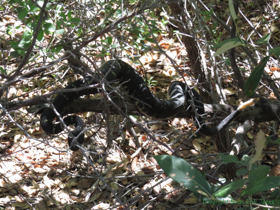
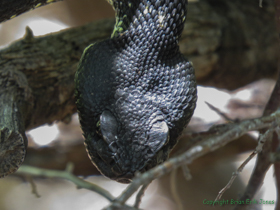
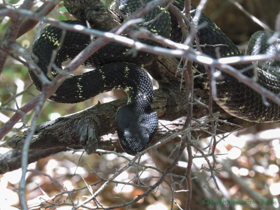
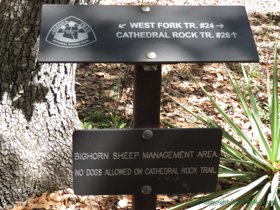
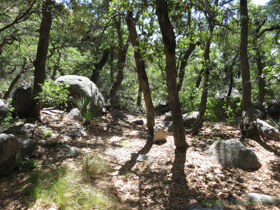
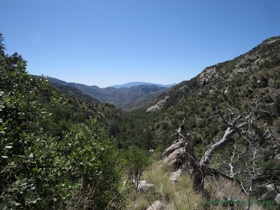
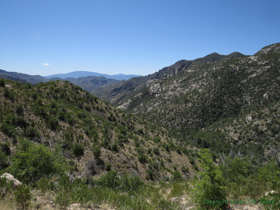
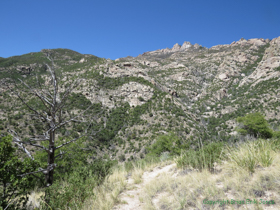
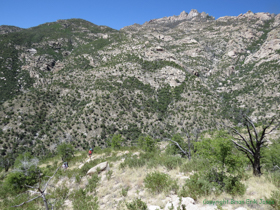


 We climbed up to Romero Pass, which marks the end of Passage 11 and the beginning of Passage 12. Again, this passage transition occurs in the middle of nowhere, so someone who is segment hiking has only the choice to continue on, or hike all the way back out. If I was king of the world, I would move the break point to Marshall Gulch. The climb up to Romero Pass is a healthy climb but from there, the trail gets steeper and rockier. So much so that it isn't recommended for equestrians. The trail climbs, and climbs, and climbs.
We climbed up to Romero Pass, which marks the end of Passage 11 and the beginning of Passage 12. Again, this passage transition occurs in the middle of nowhere, so someone who is segment hiking has only the choice to continue on, or hike all the way back out. If I was king of the world, I would move the break point to Marshall Gulch. The climb up to Romero Pass is a healthy climb but from there, the trail gets steeper and rockier. So much so that it isn't recommended for equestrians. The trail climbs, and climbs, and climbs. 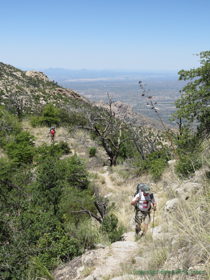
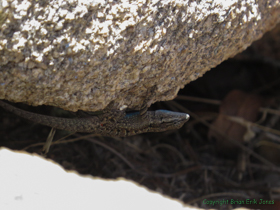
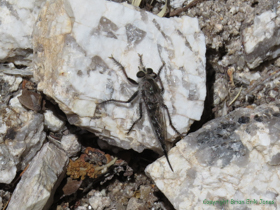
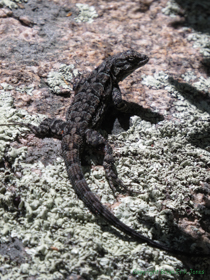

 As we climbed higher we got better and better views of the valley below. While hiking along a spiny ridgeline I looked out to the west I could actually see my house! Though at around 20 miles away, seeing it did require binoculars.
As we climbed higher we got better and better views of the valley below. While hiking along a spiny ridgeline I looked out to the west I could actually see my house! Though at around 20 miles away, seeing it did require binoculars. 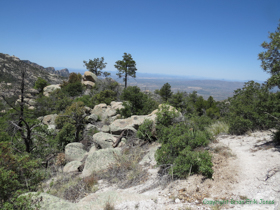
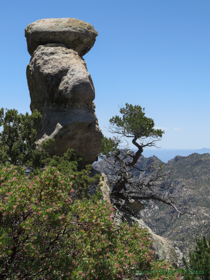
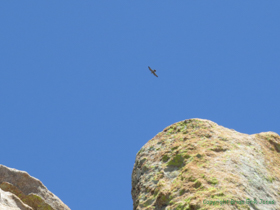
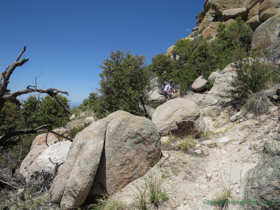
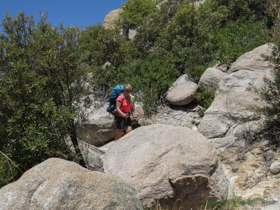
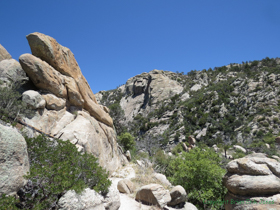
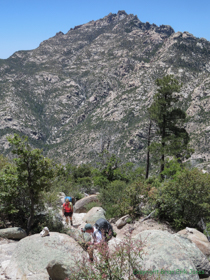
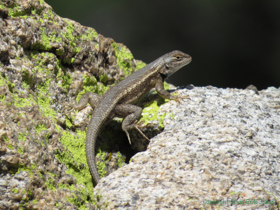
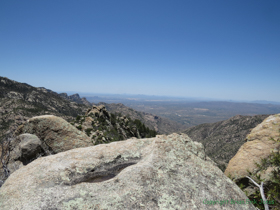
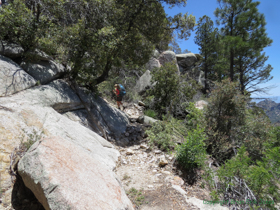
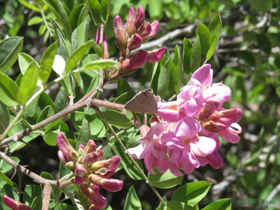
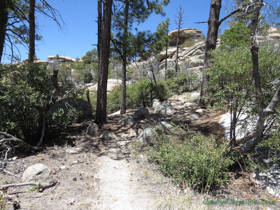

 As we neared the top we passed a campsite at which someone had left a few unopened beers. Knowing how much Jerry and Cheetah like beer, I threw a few in my pack, and Jerry took some too. I actually tried one later, and it didn't not even come close to living up to the expectation I had for a 'watermelon ale'. I should have known that beer turns pretty much anything to piss. It was good to remove them from the wilderness anyway. They really were just litter.
As we neared the top we passed a campsite at which someone had left a few unopened beers. Knowing how much Jerry and Cheetah like beer, I threw a few in my pack, and Jerry took some too. I actually tried one later, and it didn't not even come close to living up to the expectation I had for a 'watermelon ale'. I should have known that beer turns pretty much anything to piss. It was good to remove them from the wilderness anyway. They really were just litter.